A 98 year old woman in the UK wrote this to her bank. The bank manager thought it amusing enough to have it published in the Times.
Dear Sir,
I am writing to thank you for bouncing my cheque with which I endeavoured to pay my plumber last month. By my calculations, three 'nanoseconds' must have elapsed between his presenting the cheque and the arrival in my account of the funds needed to honour it. I refer, of course, to the automatic monthly deposit of my Pension, an arrangement, which, I admit, has been in place for only thirty eight years. You are to be commended for seizing that brief window of opportunity, and also for debiting my account £30 by way of penalty for the inconvenience caused to your bank.
My thankfulness springs from the manner in which this incident has caused me to rethink my errant financial ways. I noticed that whereas I personally attend to your telephone calls and letters, when I try to contact you, I am confronted by the impersonal, overcharging, pre-recorded, faceless entity which your bank has become. From now on, I, like you, choose only to deal with a flesh-and-blood person.
My mortgage and loan payments will therefore and hereafter no longer be automatic, but will arrive at your bank by cheque, addressed personally and confidentially to an employee at your bank whom you must nominate.
Be aware that it is an offence under the Postal Act for any other person to open such an envelope. Please find attached an Application Contact Status which I require your chosen employee to complete. I am sorry it runs to eight pages, but in order that I know as much about him or her as your bank knows about me, there is no alternative. Please note that all copies of his or her medical history must be countersigned by a Solicitor, and the mandatory details of his/her financial situation income, debts, assets and liabilities) must be accompanied by documented proof.
In due course, I will issue your employee with PIN number which he/she must quote in dealings with me. I regret that it cannot be shorter than 28 digits but, again, I have modelled it on the number of button presses required of me to access my account balance on your phone
bank service.
As they say, imitation is the sincerest form of flattery.
Let me level the playing field even further. When you call me, press buttons as follows:
1 - To make an appointment to see me.
2 - To query a missing payment.
3 - To transfer the call to my living room in case I am there.
4 - To transfer the call to my bedroom in case I am sleeping.
5 - To transfer the call to my toilet in case I am attending to nature.
6 - to transfer the call to my mobile phone if I am not at home.
7 - To leave a message on my computer (a password to access my computer is required. A password will be communicated to you at a later date to the Authorized Contact.)
8 - To return to the main menu and to listen to options 1 through to 9 - To make a general complaint or inquiry, the contact will then be put on hold, pending the attention of my automated answering service.
While this may, on occasion, involve a lengthy wait, uplifting music will play for the duration of the call.
Regrettably, but again following your example, I must also levy an establishment fee to cover the setting up of this new arrangement.
May I wish you a happy, if ever so slightly less prosperous, New Year.
Your Humble Client
(This was reportedly written by a 98 year old woman; DOESN'T SHE MAKE YOU PROUD!)
Thursday, September 27, 2007
Monday, September 24, 2007
Marcel Marceau est Mort.
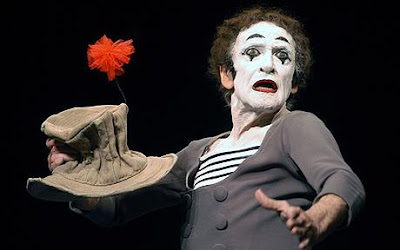
At the age of 84 Marcel Marceau (and with him, Bip the Clown) has died.
For decades, Marceau epitomised his silent art, eliciting laughter and tears from audiences around the globe. His comic and tragic sketches appeal on a universal level, with each audience interpreting his performance in its own way.
"Mime, like music, knows neither borders nor nationalities," he once said. "If laughter and tears are the characteristics of humanity, all cultures are steeped in our discipline."

On stage, he charmed with his deft silent movements, a white-faced figure in white harlequin suit, striped jersey and battered top hat.
More than this like so many of his generation he was formed by the war. His father was taken hostage and killed by the Nazis and he and his elder brother joined with the Resistance later serving with the French Army and took part in the post-war occupation of Germany.
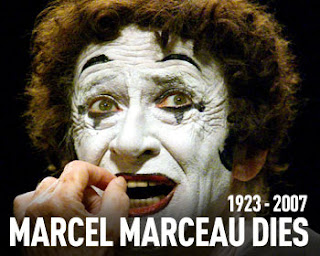
He took up acting and then mime after the war and perhaps the anguish he portrayed on stage and the insight into the human condition he expressed was a form of expiation for the horror and inhumanity of war and a Cri de Coeur against the inhumanity of totalitarianism.
Marceau famously appeared as a person refusing to appear (!) in Mel Brooks “Silent Movie. Mel phones Marcel Marceau in Paris who declines the offer, delivering the only line of dialogue in the film, in French: "Non!" When asked by the others what Marceau said, Funn explains he doesn't understand French.
Mel Funn: [seen as an insert title] Mr. Marceau, how would you like to appear in the first silent movie made in nearly fifty years?
Marcel Marceau: [the only spoken line in the film] Non!
Which is all very well but what I want to know about this great artist whose ambition was to capture the wind on stage is this; What were his last words?
Labels:
Artists,
France,
French Resistance,
Introducer’s Stage,
Marcel Marceau,
mime,
Silent Movie
Friday, September 21, 2007
The Yellow Press
In Victorian times the expression the "Yellow Press" came from "Penny Dreadfuls", newspapers printed on cheap (hence yellow) paper and full of lurid tales of the lumpen proletariat misbehaving and the latest sightings of Jack the Ripper or his maiden aunt. These were aimed at those the Victorians referred to as the "Feeble minded" - the downtrodden masses who needed to be protected from Gin, gambling, immorality and other occasions of sin. OK, the world has moved on but are the feeble minded and the yellow press not still with us?
How else do you explain the rash of trash celeb mags of which the prime example is the ironically titled "OK" owned by Richard Desmond who made his wealth from titles such as "Asian Babes" and "Bored Housewives" but who would now have us believe that he is a respectable newspaper proprietor as owner of the Daily Express.
The current edition of “OK contains hooks on the cover for articles on Glamour Model Jordan aka Katie Price and of the equally emotionally incontinent Kerry Katona, late of Atomic Kitten and marriage to Brian McFadden of Westlife. Nothing surprising here as there are articles on these two every second week as their tacky lives are charted in excruciating detail. Indeed at between 10 to 20 thousand pounds an article for “exclusive” insights into their dysfunctional lives accompanied by “amazing never seen before” photos over 5 pages of Grade A wallpaper “OK” appears to be the main source of income for these and other “famous for being famous” characters.
But a new low has been reached in the midst of the saga of the missing child Madeline McCann with the innuendo on the "Jordan and Pete" headline "We would never leave our kids on their own" and in case the lumpen proletariat are a bit slow and don’t get it the incontinent Kerry's headline on the same cover is "I would never leave my kids like the McCann's". Can there be a cheaper shot to persuade readers to buy a magazine?
Is it any wonder the UK press has such a trashy reputation when this type of journalism, accurately described by Northcliffe (A previous proprietor of the Express) as "Non news about non people" is in the ascendancy?
For the record I think Madeline McCann's parents are victims both of a crime and of trashy non-journalism. One of our friends on holiday earlier this year had a heart operation carried out by Gerry McCann at Leicester Royal Infirmary where he works as a heart surgeon and his wife is a local GP. By no stretch of the imagination do they meet the profile of people who would murder a child. This is why I was glad to see Sir Richard Branson publicly help them deal with the smear campaign - on this as on so many other things over the years his instincts are surely right.
There is real tragedy here as opposed to the manufactured in – out of Rehab / surgery / court / new lover / old lover/ bankruptcy “tragedy” which “OK” magazine and its modern yellow press equivalents rely on to titillate their remedial readership. There is an innocent child missing and the focus must return to following the evidence to solve the crime and find the missing child. The McCann’s tragedy is no worse but also certainly no less than any other family who has had a child taken from them in any circumstances. What has set this apart is the reaction of the parents, two capable people in caring professions, who have refused to lie down and play victim but who have instead run a superb campaign to highlight what has happened. Whatever the outcome for their daughter, and experience doesn’t lead us to be hopeful, they have made the possibility of future “Madeline’s” being abducted less likely and they have raised awareness of an important issue. For this and the brave example they have shown they deserve our gratitude.
As for the trash world of desperate attention seeking Celebs with no iota of talent or intelligence between them maybe we should bite the PC bullet and officially designate them as "feeble minded" and in need of protection?
How else do you explain the rash of trash celeb mags of which the prime example is the ironically titled "OK" owned by Richard Desmond who made his wealth from titles such as "Asian Babes" and "Bored Housewives" but who would now have us believe that he is a respectable newspaper proprietor as owner of the Daily Express.
The current edition of “OK contains hooks on the cover for articles on Glamour Model Jordan aka Katie Price and of the equally emotionally incontinent Kerry Katona, late of Atomic Kitten and marriage to Brian McFadden of Westlife. Nothing surprising here as there are articles on these two every second week as their tacky lives are charted in excruciating detail. Indeed at between 10 to 20 thousand pounds an article for “exclusive” insights into their dysfunctional lives accompanied by “amazing never seen before” photos over 5 pages of Grade A wallpaper “OK” appears to be the main source of income for these and other “famous for being famous” characters.
But a new low has been reached in the midst of the saga of the missing child Madeline McCann with the innuendo on the "Jordan and Pete" headline "We would never leave our kids on their own" and in case the lumpen proletariat are a bit slow and don’t get it the incontinent Kerry's headline on the same cover is "I would never leave my kids like the McCann's". Can there be a cheaper shot to persuade readers to buy a magazine?
Is it any wonder the UK press has such a trashy reputation when this type of journalism, accurately described by Northcliffe (A previous proprietor of the Express) as "Non news about non people" is in the ascendancy?
For the record I think Madeline McCann's parents are victims both of a crime and of trashy non-journalism. One of our friends on holiday earlier this year had a heart operation carried out by Gerry McCann at Leicester Royal Infirmary where he works as a heart surgeon and his wife is a local GP. By no stretch of the imagination do they meet the profile of people who would murder a child. This is why I was glad to see Sir Richard Branson publicly help them deal with the smear campaign - on this as on so many other things over the years his instincts are surely right.
There is real tragedy here as opposed to the manufactured in – out of Rehab / surgery / court / new lover / old lover/ bankruptcy “tragedy” which “OK” magazine and its modern yellow press equivalents rely on to titillate their remedial readership. There is an innocent child missing and the focus must return to following the evidence to solve the crime and find the missing child. The McCann’s tragedy is no worse but also certainly no less than any other family who has had a child taken from them in any circumstances. What has set this apart is the reaction of the parents, two capable people in caring professions, who have refused to lie down and play victim but who have instead run a superb campaign to highlight what has happened. Whatever the outcome for their daughter, and experience doesn’t lead us to be hopeful, they have made the possibility of future “Madeline’s” being abducted less likely and they have raised awareness of an important issue. For this and the brave example they have shown they deserve our gratitude.
As for the trash world of desperate attention seeking Celebs with no iota of talent or intelligence between them maybe we should bite the PC bullet and officially designate them as "feeble minded" and in need of protection?
Labels:
celebrity culture,
madeline mccann,
Press,
tabloid journalism
Wednesday, September 19, 2007
A Day in London.


London Eye
“No, Sir, when a man is tired of London, he is tired of life; for there is in London all that life can afford." Since Dr Samuel Johnson uttered these words to James Boswell in 1777 opinions have differed on whether being tired of London is just that for obviously there is plenty of life elsewhere.
What is evident is a first time visitor can become very tired of London in just one day so here is a suggested RLT (Reduced London Tour) which will keep you away from tired, tacky and amazingly expensive tourist traps, will cover a great deal of ground and give you a real insight into the long history and dynamic present of a great world city. So let’s start our day long RLT!

Whether you are already in central London or coming into its many stations your first stop is the British Museum on Great Russell Street. This is close to Holborn Underground Station (Central & Piccadilly Lines) and Russell Square (Piccadilly Line) but I suggest also take a London Taxi for the short trip to take in London at street level but make sure you have your Oyster Card which will be the cheapest way to cover the extensive ground and transport modes on your RLT.
09.30 British Museum
The Museum celebrated its 250th anniversary in 2003 and as you approach it you will notice its great portico. This is based on the portico of the Bank of Ireland (Originally the Houses of Parliament) in Dublin. The architect’s Robert Smirke’s father (Robert Smirke, The Elder) was an illustrator who painted in people on prints and had worked on prints of the Dublin building.
http://daithaic.blogspot.com/2008/10/irish-parliament-building.html
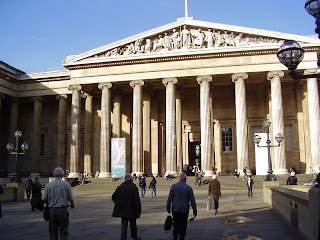
British Museum Portico
The origins of the British Museum lie in the will of the physician, naturalist and collector, Sir Hans Sloane (1660-1753). Sloane wanted his collection of more than 71,000 objects, library and herbarium to be preserved intact after his death. He bequeathed it to King George II for the nation in return for payment of £20,000 to his heirs. Today your entrance is free, which is an attractive price.

British Museum
Stride boldly into the front entrance and keep going and before you know it you will emerge into a space of wonder; The Great Court and Reading Room. Designed by Norman Foster Partners to cover what was a hidden courtyard the lightness and elegance of the parabolic glass roof design is a spectacle. At the centre is the Reading Room where Karl Marx and many others studied and researched. This has been wonderfully restored and is a confident Victorian building constructed with cast iron ribs and with an interesting exhibition on its “ticket holders” who cover the great and good of science & literature.
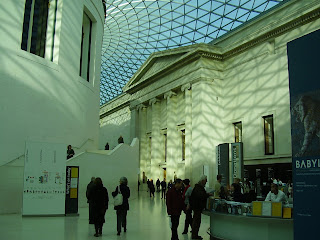
British Museum Great Court

Reading Room
Off to your left of the Great Court follow the signs to the Egyptian Room to view an almost overpowering collection of sarcophagi and mummies from the Egyptian dynasties. First on the way in stop at the Rosetta Stone, a stellae proclaiming the good works and divinity of the Pharaoh Ptolemy VI Ephiphanieas written in hieroglyph, demotic and Greek which was the key to deciphering the language of ancient Egypt and understanding its great civilisation.
%5B1%5D.jpg)
Parthenon Friezes Gallery
After this follow the signs to the front of the building to view the marbles from the Parthenon of Athens. These realistic carvings attributed to Periciles and they depict the triumphal procession of the Athenians and offerings to their god, Athena in thanks for victory. The Elgin Collection in fact contains other artefacts from the Acropolis and is displayed in a special gallery. The arrival of this collection in London in 1816 was controversial at the time with Lord Byron condemning it being taken from Greece in “Childe Harold” and John Keats praising it in an ode. This debate has been reinforced by revelations of botched cleaning in the 30’s. It should be remembered however that in the museum they can be viewed in the context of the works of other civilisations and greatest damage to the Acropolis of Athens was caused by the conversion of the Parthenon to a Christian church in 450 A.D., the explosion in 1687 when the Parthenon was ruined and the botched restoration of 1923. You could spend a week here and not see all the collections, with your appetite teased head out, across Museum Street towards Covent Garden as you can’t waste time on your RLT!
11.00 walk down to Covent Garden by Endell St. and 7 Dials.
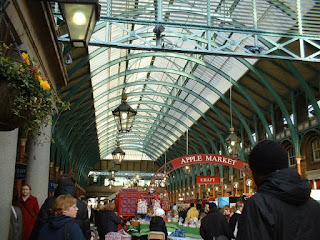
The modern story of Covent Garden began in the 1630s when land formerly belonging to Westminster Abbey, 'the Convent Garden' was redeveloped by the 4th Earl of Bedford. Today overlooked by the Royal Opera House the former vegetable & produce market has been restored to a thriving urban hub with numerous shops and street theatre, particularly on the Piazza in front of Inigo Jone’s St. Paul’s Church at the western end. At the other end of the piazza you come to the London Transport Museum.
11.30 Transport Museum, Covent Garden Piazza.
The first section of the London Underground opened from Paddington to Farringdon on 10 January 1863. A second underground line, the District, began operating five years later. The two were eventually linked to create the Circle line in 1884. The early underground was a huge engineering achievement and very well used, but had one big disadvantage. Its steam locomotives created a permanent sulphurous fug in the stations and tunnels.

This museum is child friendly with the opportunity to “drive” a tube train and speak to the “tunnelers”. It tells the story of how the Tube, trams and Buses made the world’s first mega-city possible (Reduction on your entrance with your Oyster Card). It also has a good shop and café but ignore the latter for the RLT is heading to its lunch time pit stop for refuelling.
http://daithaic.blogspot.com/2007/11/londons-transport-museum.html
Walk back towards St. Paul’s, continue down Henrietta Street and pedestrianised New Row until you come to one of London’s great squares, Trafalgar Square. Turn left and go to the fine church with the attractive steeple, St Martin’s in the Fields.
13.00 Lunch, crypt St Martin’s in the Fields, Trafalgar Square
This handsome church designed by James Gibbs, and consecrated in 1726 has a famous musical tradition and a tradition of reaching out to the underprivileged. It has served as a design template for many churches elsewhere including St. George’s in Dublin and numerous churches in the Americas. It is well worth seeing the interior and there is a market to the side. Downstairs you will find the excellent Café in the Crypt where you can have lunch, relax and soak in the atmosphere.

St Martin’s in the Fields
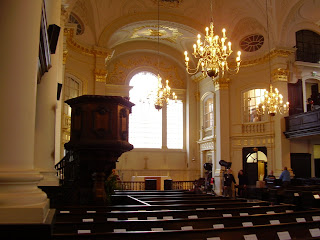
14.00 No 11 bus from Trafalgar Sq. To City via Strand, Fleet Street & St. Paul’s.
Refreshed take this bus towards the City of London from the side of St. Martin’s. This bus goes the length of London from the City to Fulham and is the best “free tour” covering many of the sites including Parliament Square, remember to use your Oyster Card! In this direction you will head down the Strand (originally the edge of the Thames) and on the right you will see the Savoy Hotel and Theatre and ahead of you the you will see the Church of St Clement Danes, the only church outside the City of London rebuilt by Sir Christopher Wren and adopted as its church by the RAF after being destroyed in the blitz of 1941. On the right is Somerset House, former home of the British Admiralty and a huge renaissance palazzo on the Thames designed by William Chambers, home to the Courtauld Art Collection and much more.
http://daithaic.blogspot.com/2008/04/eltham-palace.html

The pillar topped by a Griffin marks the boundary of the City of London and soon up Ludgate Hill the impressive sight of Wren’s masterpiece, St. Paul’s Cathedral comes into sight. The first stones of the new Church were laid on 17th December, 1672, by the Lord Mayor of London. Continue past St Paul’s (keep it for another day) and alight at Cannon Street station. Look back towards St Paul’s and you’ll realise the truth of Wren’s epitaph “If you seek his monument, look around you”. Go up Walbrook (originally a stream by the city walls, it still flows underneath) and you come to St Stephen Walbrook. Go inside to see the best (and only symmetrical) Wren church interior. There are 37 Wren churches of the 49 he built still extant and a number are a short walk from here including St Mary Abchurch and St Botolph’s. There is also London’s oldest synagogue, Bevis Marks, which is built in the same style and presumed to be by Wren or one of his pupils.
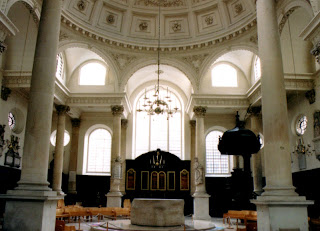
St Stephen Walbrook
At the top of Walbrook turn left and in the front of a 60’s office block you will find the Temple of Mithras. This is a Roman temple dating from the 3rd Century, The cult of Mithras was a Persian cult with adherents in the Roman Army who were attracted to it being an all male cult. It has many similarities with the later Christian worship including redemption through a blood sacrifice and its temples were the model for the Christian basilicas.
Temple of Mithras
Across the road the modern building on the Apex is No. 1 Poultry designed by James Stirling. In front of you at the apex of this building is the Mansion House and the Bank of England, “The Old Lady of Threadneedle Street”. Walk down King William Street to Monument and ahead of you behind the underground station is the Monument built to commemorate the Great Fire which devastated the City of London in 1666. Standing 202 feet high, the Monument is the tallest isolated stone column in the world. Designed by Sir Christopher Wren and Robert Hooke and constructed of Portland stone in 1671-7, the simple Doric column is topped by a flaming urn of copper symbolising the Great Fire. Climb the spiral staircase of 311 steps to the balcony at the top and you are rewarded with breathtaking views over the city in all directions, as well as a certificate of achievement.

Monument to Great Fire
15.00 Docklands Light Railway (DLR) - Bank to Island Gardens via Canary Wharf. Go into Monument Station (which is joined to Bank) and find the DLR and get into the front seats and you will enjoy “driving” these driverless trains through the tunnel before you emerge for a tour of London’s Docklands taking in the impressive new financial district of Canary Wharf and alighting at the station before Greenwich, Island Gardens.
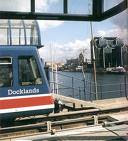
Docklands Railway
Go into the park across from the station because now you are going to walk under the River Thames to Greenwich under the Thames through the Greenwich Foot Tunnel!
The riverside at Island Gardens gives a splendid view of Maritime Greenwich and in front of you (go to the left of the tunnel entrance)the Royal Naval College is across the river framing Inigo Jones Queens House. Begun for Charles II by architect John Webb, it was completed by Christopher Wren, Nicholas Hawksmoor and John Vanburgh as the Royal Hospital charity, founded by William and Mary in 1694 to care for disabled and veteran sailors and behind it on the hill is Greenwich Observatory and Park. This vista and these buildings form a UNESCO World Heritage site which can only be properly seen from this view point.

Royal Naval College, Greenwich
Designed by Sir Alexander Binnie, the Greenwich Foot Tunnel opened in August 1902 so that south London residents could go to work in the docks on the Isle of Dogs and is my favourite price, free! So take the atmospheric lift and walk under the river and emerge at Greenwich to briefly enjoy Greenwich waterfront & Cutty Sark clipper ship –which is being restored before going down to Greenwich Pier.
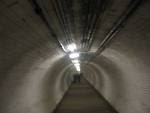
Greenwich Tunnel
16.20 boat from Greenwich (City Cruises) to Waterloo Pier.
Remember you get a third off the fare with your Oyster card as they don’t go out of their way to tell you. Enjoy London the way it should be seen from the river as you go past Canary Wharf, Tower Bridge, Tower of London and head up past St. Paul’s and the Tate Modern to Westminster alighting at Waterloo Pier.
18.30 London Eye
The London Eye is the world's tallest observation wheel at 135m high. Located on the banks of the River Thames it offers unrivalled views over London. It is a dramatic work of sculpture in its own right by Bayfield and Marks, Architects, is like a bicycle wheel supported on one side as it dramatically hangs over the River Thames. Book tickets online beforehand and collect them in the automatic machines when you arrive.
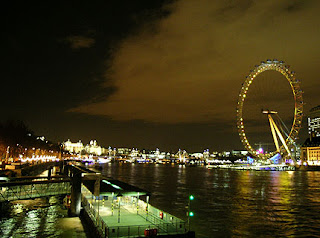
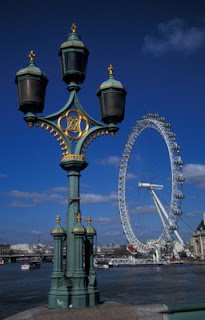
19.00 On foot across Westminster Bridge taking in the famous vista which the poet Wordsworth immortalised.
COMPOSED UPON WESTMINSTER BRIDGE, SEPT. 3, 1802
EARTH has not anything to show more fair:
Dull would he be of soul who could pass by
A sight so touching in its majesty:
This City now doth, like a garment, wear
The beauty of the morning; silent, bare,
Ships, towers, domes, theatres, and temples lie
Open unto the fields, and to the sky;
All bright and glittering in the smokeless air.
Never did sun more beautifully steep
In his first splendour, valley, rock, or hill;
Ne'er saw I, never felt, a calm so deep!
The river glideth at his own sweet will:
Dear God! the very houses seem asleep;
And all that mighty heart is lying still!
Past the Houses of Parliament and Westminster Abbey, up Toothill Street and turn right at 55 Broadway (London Underground’s headquarters above St. James Park Station adorned with sculptures by Moore, Epstein, Gill and others)thru Queen Anne’s Gate to St James Park.
http://daithaic.blogspot.com/2008/04/give-my-regards-to-55-broadway.html
View Buckingham & St James Palaces, Horseguard’s Parade and Churchill’s War Bunker. Up the Carlton Steps to Piccadilly, onto Leicester Square and to Chinatown which is in a block off Shaftsbury Avenue bounded by Lisle Street and Gerrard Street.
20.00 Chinese Meal in Chinatown and afterwards home for a well earned rest. The restaurant I’d recommend for cheap eats and atmosphere here is Wong Kei in Wardour Street. Spread over 4 floors it has over 600 hundred seats and plenty of authentic Chinese atmosphere (cash only, no cards or cheques). For authentic Cantonese food order the noodle or rice dishes from the back of the menu, Fried Quaedu, Beef Ho Fun, Singapore Noodle, Soup Noodle, Foo Yung Fried Rice etc; These and a bowl of soup and free Chinese tea will be under five pounds but you may well feel hungry two days later!
http://daithaic.blogspot.com/2011/02/kung-hei-fat-choi-happy-chinese-new.html

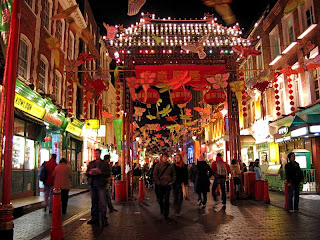
Chinatown
Congratulations! You have now completed the RLT successfully. More importantly you have seen some wonderful panoramas and sights and got wonderful value out of London’s great public transport system whilst avoiding tacky overpriced (mostly you have paid FREE!) tourist sites and restaurants all the time drinking deeply of this unique city’s sight and sounds. Keep London real, do the Reduced London Tour!

Labels:
Avoiding Tourist Traps,
British Museum,
Canary wharf,
Covent Garden,
Destinations,
Docklands Light Railway,
London,
London Eye,
St Martin’s in the Fields,
St. stephen Walbrook,
Travel
Tuesday, September 18, 2007
Upton House, Oxfordshire.
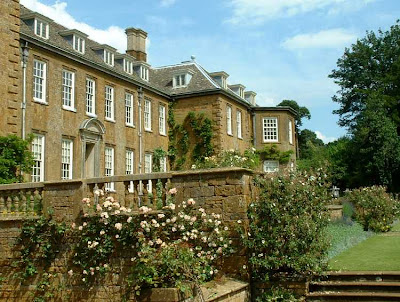

Bog Garden

Entrance Front
The National Trust was founded in 1895 by Octavia Hill and today is probably the world’s leading conservation body with hundreds of houses under its steward ship as well as 700 miles of coastline and many acres of important landscape in England & Wales. The houses and attractions open to the public are not tourist attractions but are buildings, lands and monuments which are conserved or restored in various degrees and are owned in trust by 3.4 M members. As such they provide some wonderful venues for visitors which give a real insight into the life of England away from the well trod tourist traps.

Garden Front
One such place is Upton House the house of Walter Samuel, Viscount Bearstead, the Chairman of Shell Oil and son of its founder. In the 1930's he was one of the richest men in the world and this was his weekend house bought to entertain and go hunting and remodeled to house the art collection begun by his father. It is on the edge of the Cotswold’s, between Banbury and Stratford-upon-Avon. If going by car go from either junction 11 or junction 12 on the M40 and you will pick up the distinctive brown direction signs with the Nation Trusts oak leaf symbol. This is a delightful corner of Oxfordshire with picture postcard villages with hugely attractive thatched cottages with the thatch contrasting with the reddish / brown local Hornton stone.


The approach to Upton House is unassuming with little hint of what is beyond other than the rather austere North Front in the same reddish local stone. One of the National Trust's most important art collections can be found in this house. Today you can imagine you are joining the guests of Lord and Lady Bearsted and experience the weekend house party of a 1930s millionaire. You are surrounded by the internationally important art and porcelain collections. The stunning gardens being returned to their 1930s heyday consist of a sweeping lawn, giving way to a series of terraces and herbaceous borders leading to a kitchen garden, tranquil water garden and the National Collection of Asters.


Built in about 1695 for Sir Rushout Cullen, Upton is a long low house built of local yellow sandstone. Perhaps uniquely among country houses owned by the National Trust it was acquired almost entirely for its art collection and it is presented more as an art gallery than a private home. Purchased and remodeled in 1927–29 by Walter Samuel, 2nd Viscount Bearsted, who was Chairman of Shell, 1921–46, and son of the company's founder. Upton contains his outstanding collection of English and continental Old Master paintings over three floors, including works by Hogarth, Stubbs, Romney, Canaletto, Brueghel and El Greco; Brussels tapestries; French Sèvres porcelain; Chelsea and Derby figures and 18th-century furniture.

Lord Bearsted, 1922. Portrait of Marcus Samuel, Lord Bearsted, British businessman and founder of the Shell Transport and Trading Company.


Gravestone of Marcus Samuel Bearsted, founder of the Shell Oil Company, United Synagogue Willesden Cemetery, Willesden, London.

The second viscount donated it to the National Trust in 1948 with the collection and an endowment and the proviso that it is displayed as a family house, not as a museum. Indeed, the family lived here until 1988 and still owns the extensive grounds where they live in a modern house. The house was remodeled in the late 1920’s and the combined Library, double height Picture Room, Art Gallery and Billiards’ Room combines both a sense of grandeur and an English gentleman’s club atmosphere. The other “Gosford Park” style feature is the separate luggage lobby where visitor’s belongings would be taken up the backstairs to their bedrooms whilst they were no doubt welcomed with agreeable cocktails!

The collection was assembled by Walter Samuel, 2nd Viscount Bearsted who owed his fortune to the fact that his father Marcus Samuel was the founder of the oil company Shell Transport & Trading. He acquired Upton in 1927 and gifted it to the National Trust in 1948. The collection includes English and Continental old masters by artists such as George Stubbs, Jan Steen, Melchior de Hondecoeter, William Hogarth, Thomas Gainsborough, El Greco, Joshua Reynolds, George Romney, Tintoretto, Rogier van der Weyden and Pieter Bruegel the Elder.
There is also a collection of English porcelain, including Chelsea, Derby, Bow and Worcester, and some French Sèvres porcelain. The house also contains an art deco bathroom and a collection of early Shell advertising posters.


Upstairs there are a number of suites decorated in the Art Deco style including Lady Bearsted's restored bedroom and Art Deco bathroom which is covered in aluminum leaf. Also upstairs there is an exhibition of paintings and publicity posters commissioned by Shell during Viscount Bearsted's chairmanship; In the 20’s to 50’s Shell under Jack Boddington and London Transport under Frank Pick commissioned some of the most memorable advertising seen in Britain. As well as posters and billboards with slogans such “You’re going well, you’re going Shell”. As well as the posters the company produced post cards, maps and the Shell Guide’s which are now valuable collectors’ items. They form a testament to the great creativity in graphic design and art in the 20s and 30s as well as documenting a simpler age when the car was seen as a form of liberation!

Garden Stairs
Standing on the terrace on the South Front there is little hint of the glories beyond looking at what appears to be a ha-ha framed on one side with majestic Cedars of Lebanon planted in 1700 on the right and ancient yews framing an Alpine garden on the left. As you approach the bank the ground falls away and there below you is the unusual centre piece – a wonderful Kitchen garden framed by 2 remaining out of 4 “stew lakes” which provided fresh fish for the house. The garden is very fine, with lawns, terraces, orchard, herbaceous borders, kitchen garden, ornamental pools and an interesting 1930s water garden, together with the National Collection of Asters. The kitchen gardens provide a wonderful range of produce with, for instance, 6 types of apple tree. This and the other variety of plants, fruits and flowers were not designed to impress but rather to ensure fresh produce was available for as long as possible. The apples would have different ripening and storage times to ensure as long a season as possible.
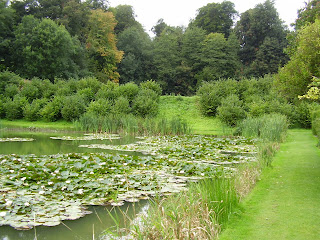
Stew Lake
The 31 acres of gardens are full of character. Terraces linked by an Italianate balustraded stairway added in the 1930s overlook a formal lake. There is a wilderness-like bog garden in a natural amphitheatre ringed by woods to the west of the house. A classical temple by Sanderson Miller is built above a larger lake. The mellow brick wall of the 17th century kitchen garden still has carries espaliered fruit trees.

Mirror Pool
There is a fine cafeteria in one of the pavilions which serves a simple range of good fresh food and a visitor shop which serves a good range of gifts, local foods and garden plants grown in the grounds and greenhouses. All in all this has much to offer as a visitor destination with a fine English as it would have appeared in the 20s and 30s, a wonderful collection of art and artifacts and attractive historic gardens to enjoy with an array of colours and interest throughout the seasons.
Location: Near Banbury, Oxfordshire.
For more on Architecture and Design see ArchiBlogs in the Blog sidebar.
Friday, September 14, 2007
The Euro - OPPORTUNITY OR THREAT FOR BRITAIN ?
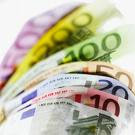
With the debate taking place on the European Treaty and it’s consequences there is a revivial in the UK on the debate on European Monetary Union (EMU), represented by the currency unit, the EURO which has become an icon of admiration or contempt depending on the side of the debate the speaker represents.
Indeed to refer to the discussion as a "debate" is perhaps to over dignify it as the Eurosceptic viewpoint is increasingly withdrawing into a caricature of "Little England" postures whilst the pro Europe lobby appears to be in love with their "communitaire" self image and making little attempt to "sell" the issues to the wider public.
However the issues are real for the future of Britain and the lack of true dialogue and constructive debate on the issues is worrying. The schizophrenic response in the UK to the European monetary union in 1999 however accurately reflects the history of a country which has 3 times in the past 200 years united with Russia to oppose the emergence of a central European power bloc but whose own Prime Minister, Winston Churchill, called in 1945 for the creation of a United States of Europe to combat the re-emergence of a divided Europe.
In the end countries are guided in their policies by self interest and here we attempt to address the real issues posed by the EMU and answer the question " Is European Monetary Union in the best interests of the UK ?"
The real debate is between those "free marketers" such as Prof. Alan Walters who argue passionately (and with history on their side) that fixed exchange rate mechanisms have always self destructed due to internal conflicts but not before they have caused considerable damage in the process and the Federalists such as Jacques Delors who argue that the future is the only reality and that Europe to compete with the emerging Pacific economic powerhouse will have to develop a genuine single market and this is only possible with a single currency and unified economic policies.
A single currency for the European Community was at the heart of the Maastricht Treaty for Economic and Monetary Union (EMU) signed in 1991. The then twelve EC members set a 1999 deadline for introducing the currency but only in those countries meeting economic criteria laid down in the Treaty. However, it is clear now that most EC economies are unlikely to pass the Maastricht tests, threatening delay or even abandonment of the project.
Monetary union would be a decisive step towards political integration - a United States of Europe. The opt out bty the UK from the Euro was a possibly mortal blow to the dreams of pro - Europeans or 'federalists' whose ultimate goal is political union. On the other hand, 'Euro - sceptics', opposed to further European integration, were reinforced in their opposition to the euro. These opposing attitudes towards EMU have been taken up largely independently of the merits and demerits of a single currency on economic grounds.
The driving force behind the Community (known since Maastricht as the European Union or EU) has always been political as envisaged by Winston Churchill and Jean Monet, the founding father of European Union.
The process begun in 1957 with the Treaty of Rome which established the European Economic Community (EEC) has evolved from a customs union among the original six members into a huge common market of twenty seven countries with a population of 500 million a nominal GDP of Euro 11.6 (US$15.7) trillion in 2007
Monetary union logically implies a high degree of political integration. Thus the supply of a single currency is regulated by a European Central Bank (ECB). National governments and central banks have therefore lost their independent control or sovereignty over monetary policy, for example, in the setting of interest rates. Also, because governments' budget deficits or surpluses have monetary implications, there is growing centralised co - ordination of national spending and taxation.
Fear that national parliaments would thus cede their sovereignty over macroeconomics policy (and ultimately the power to levy taxes) to EC institutions explains the often violent opposition to the single currency from Euro - sceptics. But similar if less visible antipathy towards European integration is to be found across the political spectrum and in other countries as well as the UK. In 1994, for example, Norwegians voted to reject Community membership which had been negotiated by their government.
The Maastricht Treaty lays down achievement of EMU in three stages. While the decision to join EMU or not is ultimately political, a rational judgement must also take into account the potential economic benefits and costs of a single currency. At first sight the economic case for a single European currency is a convincing one. The chief argument in favour of EMU is that a single currency is required to maximise the benefits of the Single Market or, to use its formal title, the European Economic Area (EEA). The EEA came into being in 1993 as a free trade area of all fifteen EC countries together with a few non EC countries such as Norway. The aim of the EEA is to create a genuine common market, removing all barriers to trade in goods and services and to movements of labour and capital between countries.
An indirect benefit for some countries would be lower interest rates from the elimination of the interest rate risk premiums on their currencies which could have a beneficial effect in raising investment levels in the EC and the rate of economic growth in the long term.
Proponents of Euro also claim that a politically independent European central bank, modelled on the German Bundesbank, would be more successful than other national central banks in curbing and holding down inflation. But this benign outcome is by no means certain as the ECB's monetary policies would be determined by majority voting among representatives of national central banks. It is easy to imagine at a time of recession that monetary hard-liners win be outvoted by those favouring easier policies and lower interest rates. The euro could thus be a much 'softer' currency than the Dmark.
Further, it is argued that the euro could rival the US dollar as a vehicle currency, that is, a currency which would be widely accepted internationally for making payments, trade invoicing and a store of value in countries outside the EC. But such a role for the euro depends on the ECB pursuing low inflation policies.
More important than the costs of introducing the single currency are the potential economic problems arising from the centralisation of monetary and fiscal policy. An analytical framework here is provided by the theory of optimum currency areas pioneered in the 1960s by Canadian economist Robert Mundell. For Mundell the key criterion is factor mobility - that is, the ease with which capital and especially labour can move between the different states and regions in a currency area. However in the immortal words of Norman Tebbit there is no presumption that workers would " .. get on their bikes .." across Europe in search of opportunities and if they had to, would this be politically acceptable in the UK ?
So, without separate currencies and flexible exchange rates, there could be huge regional adjustment problems in the EC. For example, in the past the UK has been able to offset its relatively high inflation by depreciation of the pound against the Dmark — since 1966 the pound has slumped from over 11 marks to around 2.25! The danger is that high -inflation or low - productivity economies would become chronically depressed, demanding permanent regional transfers from Germany and other richer states. In fact, the Maastricht Treaty already provides for such transfers in the form of 'cohesion funds' for Spain, Portugal and Greece—the 'Club Med'—and Ireland.
We already have a practical example of this difficulty in the UK, which has had a unified currency since 1736. Here there are considerable regional disparities with high levels of structural unemployment in Scotland, the North East and Northern Ireland whilst the South East has always had lower employment and higher standards of living than the regions. In an EMU would Britain a region with the inability to address it's own specific regional economic problems?
However, the Maastricht criteria are purely financial. They ignore the large divergence's in real economic variables such as labour productivity, unemployment and income per head. Ironically, the attempts made by France, Spain and others to achieve convergence with Germany on inflation and budget deficits have merely increased real divergence. To curb their budget deficits governments have pursued austere fiscal policies, pushing their economies into recession and forcing up unemployment - to near 12% in France and 23% in Spain.
There is widespread and growing disquiet about the consequences of the Euro, especially as the preparations for it already seem directly responsible for rising unemployment in Europe. Some argue cogently that the regional imbalances from monetary union will be a source of conflict not harmony between states. Popular resentment about high unemployment in depressed regions and about the scale of financial transfers to them from richer states could lead to a possibly violent break-up of monetary union.
At the end of the day Britain by delaying entry to the Euro, against former Prime Minister’s Tony Blair’s known instincts, is probably in the worse of all circumstances, marginalising itself from the rest of Europe by not influencing the implementation of the single currency. Only if there is a consensus and if it results in a more competitive an prosperous Europe and if that prosperity is evenly distributed. For this to happen God will be in the details and Britain cannot afford to echo the classic Times headline from 1904 - "Fog in the channel, rest of Europe cut off".
Thursday, September 13, 2007
Mexican Covent Garden

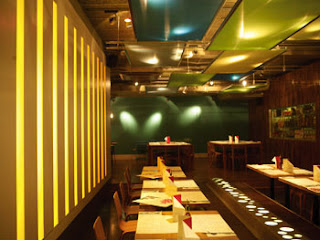
After work across St James Park to the ICA (Institute of Contemporary Art) on the Mall. This Park on the cusp of dusk is a treasure of London with squirrels heedless of humans bounding across the flowerbeds, families of geese and ducks going for their evening constitutional and pelicans feeding on the lake island. This and all around wonderful vistas of the city.
After an abortive attempt to see the Darfur Documentary at the ICA on the Mall perambulated across Trafalgar Square to Chandos Place, between the Strand & Covent Garden where I was anxious to try a new Mexican restaurant offering "Market Fare", small dishes and snacks as you would get from street stalls in Mexico. During the exodus from countryside to cities, traders began offering this familiar "home-cooked" food to newcomers. Stalls sprang up selling regional favourites from the states of Oaxaca, Michoacan, Sinaloa, the Yucatan and Vera Cruz, giving rise to the diversity that is modern day Mexican street food. This is the type of unpretentious but flavoursome cuisine Wahaca tries to replicate in a attractive and airy setting in London's bustling Covent Garden.
Wahaca (A play on the pronunciation of the Oaxaca province) is a new restaurant that raises the level of Mexican cuisine high about the usual oil-laden Tex-Mex fare.
Founded by chef Thomasina Miers, winning of UK Masterchef in 2005, the restaurant offers traditional Mexican market food using the best local ingredients. Using the soft corn tortilla as its base, street food originated with wives bringing farmers their mid-day meals by using tortillas as wrapping.
In Mexico, there are as many ways of eating as there are flavours. You can have a healthy salad lunch (served in a tortilla nest), light snack or antojitos (little treats) with drinks. Share small dishes with friends, or have a hearty taco all to yourself. The food all tasted good, hugely flavoursome and fresh.
We ended with the churros, which if you have never had it, is a Mexican institution and must be ordered; it's like fried donought served with thick melted chocolate for dipping. Amazing. Some pointers for a future trip are the 15 tequilas (with tasting notes!) on the menu and numerous variations on the Mojitos theme - a theme well worth exploring - however I will need to begin preparatory training first!
A really nice space with good touches like the stone sink to wash your hands on the way in as you often see in Arabic countries - you don't use cutlery with Mex food!
All this in wonderful company with my companion (A high achieving Consultant) treating me out of well intentioned compassion as she is saddened by my lack of achievement. A hearty meal for two with Mexican beers is easily possible for under 30 pounds in total.
Aye Carrumba!
Tuesday, September 11, 2007
Input and Output Measures.
The difference between Input and Output measures often is a source of confusion when discussing performance measures. This illustration may help to explain this difference.
The Arch Metropolitan Theodrakis Christodoulou was for many years the much loved pastor of his flock in his sprawling See in rural Greece. His family were of simple farming stock and the young Theodrakis was a keen student at the humble village school, walking bare foot 3 miles there and back in weather fine and foul and never missing a lesson. His application commended him to the village schoolmaster who took the young boy under his wing and lent him books his family couldn’t afford. These, the young Theodrakis devoured as if they were manna from heaven and when he graduated he had no doubt that his vocation was to serve God. He entered the theological seminary in Thessalonica where he excelled in his studies but moreover impressed all who met him with his piety and sense of purpose.
It was the proudest day for his mother and father when the son they had reared was ordained as an Orthodox Priest and nobody was surprised with his scholarship, piety and humility meant that many years later he was raised to the Episcopacy and later still conferred with the honoured title of Arch Metropolitan. As their Arch Bishop the poor and devout people of the diocese loved him for his holiness and charitable works and respected that he never spent money on himself, refusing to renovate the ramshackle Archbishop’s Palace or have an official car to travel across his far flung flock. Some said he had the loveliest smile, others testified to his saintly aura and some credited his laying on of hands with curing their ailments. After a long life of good works, God took pity on his ancient frame and called The Arch Metropolitan Christodoulou to him, causing great sadness among the faithful.
Soon he found himself making the journey for which he prepared all his life to meet St. Peter (Agios Petros) at the Pearly Gates. Old St. Peter greeted him warmly, despite the long queues, (demand management was difficult in Heaven, it was either a feast or a famine), he checked his clip board and addressed the Arch Metropolitan Christodoulou thus: “Welcome to heaven, your beatitude, we have allocated you a bronze seat, second class, in the upper tier of Heaven. It is a bit far back but you will have a clear view of the Heavenly Throne if you use the binoculars which you’ll find in the seat pocket in front of you.”
Christodoulou replied “by His Grace I am His humble servant, to be in His celestial presence is the greatest reward I who are not worthy can dream of!” and with that he shuffled off up the long flight of steps to his bronze seat, second class, upper tier.
As he stopped to catch his breath he noticed Costas the Coach Driver, who had died the same day when his liver packed in after a life of self serving drunkenness and debauchery, had rolled up to the Pearly Gates. Christodoulou allowed himself a wry smile for despite his piety he was human after all. He was really surprised that Costas had made it to heaven in the first place but was happy for him as he believed in personal redemption. However he knew Costas was due for a rough reception from St. Peter having spent a selfish life grubbing shamelessly for tourist tips on his coach tours, taking them to be fleeced at tourist traps where he got a rake off and behaving scandalously, particularly with those English girls who had a certain reputation.
Imagine his surprise as he heard St. Peter say to Costas the Coach Driver “OK Costas, I think you should be happy, you have been allocated a Gold seat, second class, front tier so you will be right in the centre of all that good God action!”
The Arch Metropolitan Christodoulou was stunned and then his astonishment turned to righteous anger as he thought of the honour conferred on Costas who had led such an unworthy life compared to his. Defying the habits of a lifetime he found himself striding towards St. Peter to let him know what he thought of this travesty!
“Good Saint Peter, I was happy with my lot in heaven until I saw the honour you have conferred on someone as unworthy as Costas the Coach Driver! “
St. Peter looked around sternly at the agitated Archbishop and his demeanour changed as he spoke in a strange tongue called Management Speak.
“Bish, get a grip I’m only following orders, we have a new performance regime for Heaven the reassuringly expensive Celestial Consultants have put in based on Output Measures.”
His Beatitude looked abashed at the change in tone and the strange tongue but eventually found his composure to splutter:
“I am a simple servant of God; I have no idea what you are saying to me!”
St. Peter tried to be patient as he explained.
“Look Bish, under the old fashioned system of input measures with your good life and works you would have come out on top but with these new output measures it’s all down to the bottom line and that is where Costas the Coach Driver comes out on top.”
The Bishop blinked and said lamely “I still don’t understand!”
“Bish, you need to change your ideas, as I said we are only interested in the bottom line for Heaven Inc. The Bottom line based on outputs is despite your good works you only got people to pray on Sundays. Costas the Coach Driver on the other hand had coach loads of tourist screaming with fear as he went too fast around mountain bends and forced them to pray seven days a week!”
The Arch Metropolitan Theodrakis Christodoulou realised that he didn’t count in the new output based performance regime installed by Celestial Consultants and, making as little noise as he could, quietly shuffled off to his bronze seat, second class, in the upper tier of Heaven.
Subscribe to:
Posts (Atom)